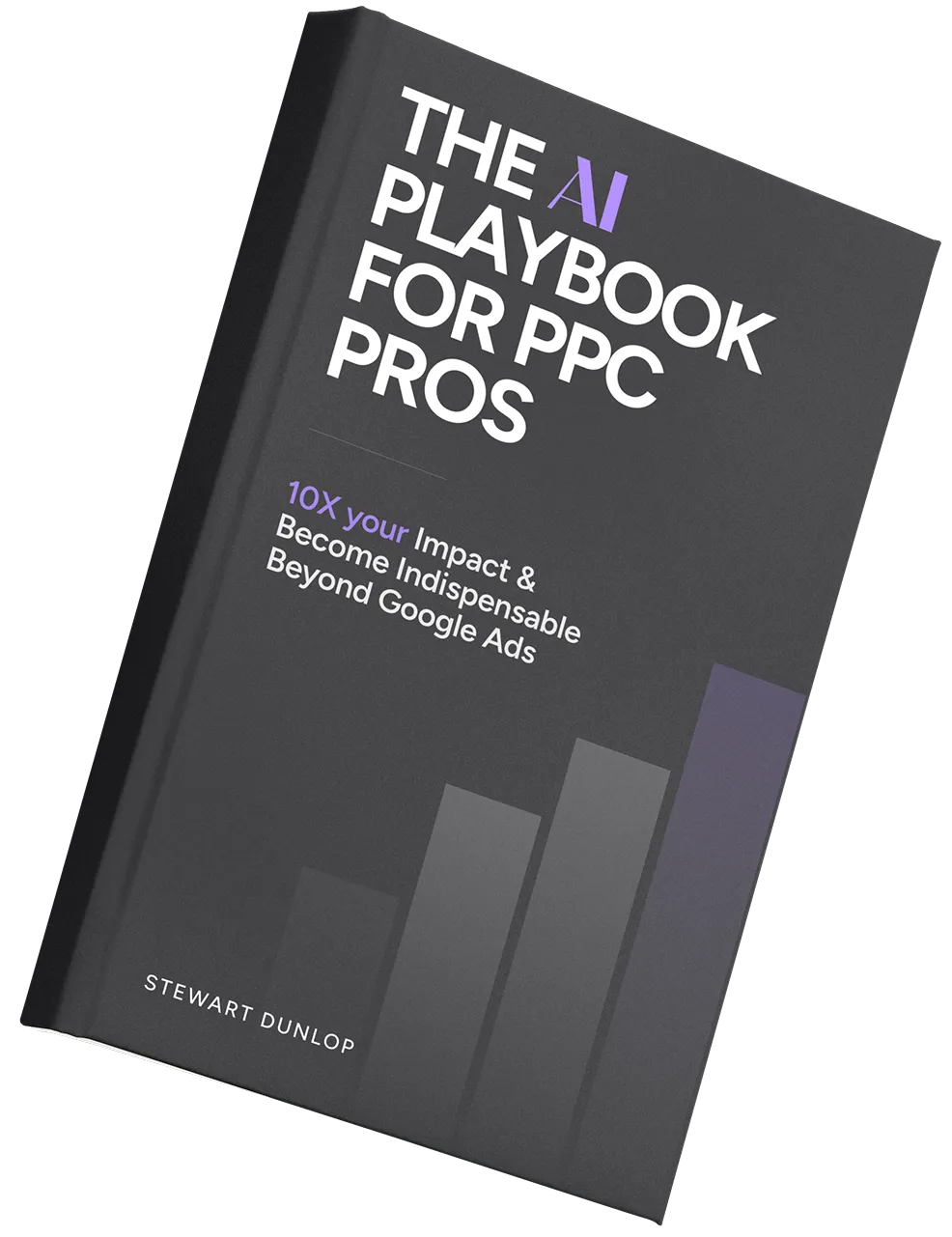
It’s easy to start Pay Per Click (PPC) advertising. Just sign in to Google or Facebook and create a campaign.
But as you get more familiar with the platforms, you’ll realize being successful takes a lot of work. You’ll need to create and test different ads, find keywords, and check your competitors.
The best PPC tools help with all this and more. But there are so many that it can be confusing to decide what you need.
We spend a lot of time working with different software solutions, so we know what makes a great tool to help you increase your ROI from PPC marketing. This list includes 11 of our favorites.
P.S. If you're an agency check out this guide 👉 12 AI Tools I'd use to scale my agency again
Some of the PPC tools listed are paid, some are free. Some are built for agencies managing multiple accounts, while others are good for small business owners trying to drive traffic.
Whatever you need a tool for, we’re sure you’ll find it on this list.
12 Best PPC Tools
We’ve put together a list of our favorite tools which really do help us maximize performance.
1) SEMRush: For Keyword Research and Competitor Analysis
SEMRush is an all-in-one digital marketing tool. It helps with SEO, social media, content marketing, and more.
Where it stands out, though, is with search ads. And its PPC Advertising Toolkit contains many features that can help you plan and optimize your campaigns.
Our favorite features are the Market Analysis tools. These give you deep insight into your competitors’ PPC campaigns, showing metrics like:
- Which businesses are targeting similar keywords.
- Other keywords these competitors are bidding on.
- Examples of their PPC ads.
- Keywords multiple competitors are targeting that you aren’t.
All this information makes it easy to spot new keyword opportunities. Use these to maximize your ad spend and get a higher return on your investment.
Here’s an example of how it can help:
Imagine you wanted to sell sneakers. Searching for nike.com will show you a ton of information about the sportswear giant’s PPC campaigns, including the terms it bids on and other competitors.
You can see the overview in the image below. Clicking on any of the links will show more information—including all 5,644 keywords the company bids on.
This is super valuable data for anyone interested in competing for these terms.
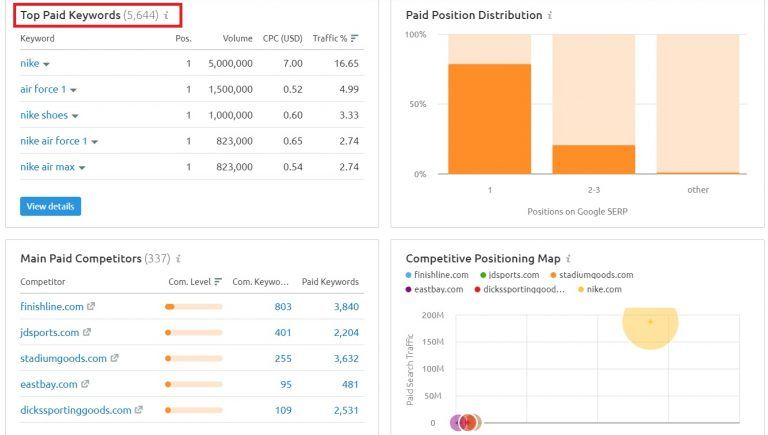
All this functionality doesn’t come cheap, however.
The SEMRush Pro plan costs $119.95 per month, and the Business plan goes up to $449.95. Additional extras can add hundreds of dollars per month to your bill.
Still, if you’re spending a lot on ads it may be worth giving SEMRush a try. It’s a great PPC tool, and there’s always the seven-day free trial you can use to test the software out before committing.
2) SpyFu: Affordable SEMRush Alternative
If you like the sound of the competitor research features of SEMRush but don’t want to splash out over $100 per month on a PPC tool, SpyFu is a good option.
It offers plenty of similar features at a much lower price point.
For example, you’ll still get:
- The ability to see what competitors are bidding on.
- How their ad spend changes over time.
- The keywords they are targeting that you aren’t.
- A PPC rank tracker.
It’s everything you need to track your competitors and gain keyword insight.
One feature that can save you a ton of money is the negative keywords tool.
It works by scanning all the PPC keywords you are bidding on to show you which ones competitors have placed on their negative keywords list. This is a list of keywords they have told Google they don’t want to bid on.
Businesses usually place keywords on this list when the terms aren’t performing. Knowing which terms competitors have put on their list means you can do the same without having to spend money finding out they don’t convert.
Another way to save money is to look for keywords you buy but other brands avoid. The idea is that if no one else is bidding for the keywords, they might not be worth much.
Check out the image below showing the keywords Nike is bidding on that no other brands are targeting.
Three of the keywords are branded, which is probably why no one else is bidding on them. But the fact that no one is bidding on hoodies or jordan suggests these keywords may have low buyer intent.
Having this information when performing keyword research can save you money.

SpyFu’s basic plan costs just $39 a month ($33 billed annually), making it an excellent way to get competitor research at a fraction of the cost of SEMRush.
There’s also a Pro plan at $79 a month ($58 billed annually) and a Teams plan that comes in at $299 a month ($199 billed annually).
You can get a 30-day money-back guarantee, and there’s also a limited free version that allows you to test the features out.
3) Google Keyword Planner: Google Ads Keyword Research Tool
Keyword planner is a free keyword research tool from Google Ads. You can access it as soon as you sign up for Google ads via the “Tools” menu in the top bar.
It helps you plan PPC campaigns in two main ways.
- It helps you discover new keywords.
- It provides information about these keywords, such as volume and estimated cost, which is great for bid management.
Using it is easy.
Just enter your target keywords in the search bar and Google will show you a list of related terms alongside how many searches they get.
You’ll also see how competitive the keyword is and the amount other companies are spending on each term.
Below you can see suggestions based on the umbrella term “email marketing tools.”
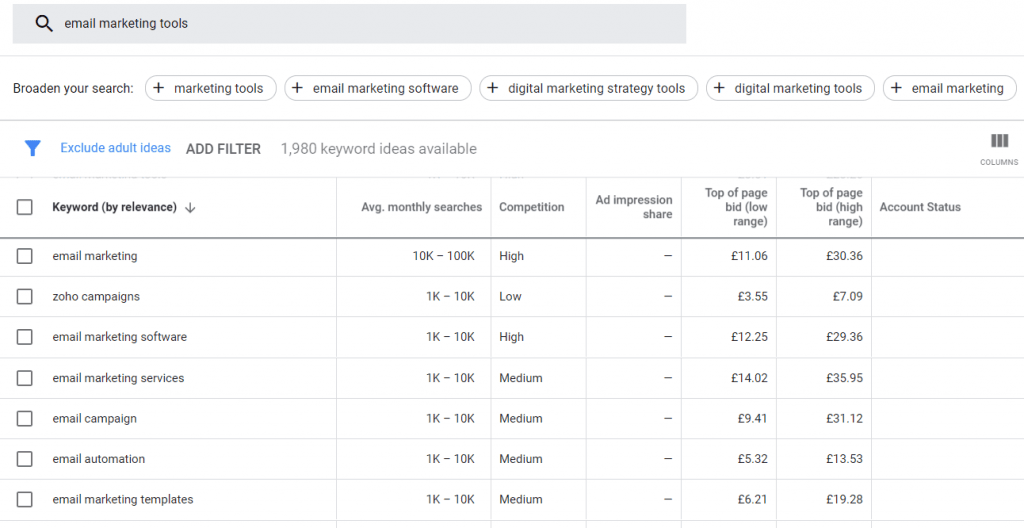
Be sure to narrow down your search by filtering the results based on the language and the country you are targeting. You can even target specific cities or regions.
When you find good terms, check the box to create a new ad group.
The tool’s keyword analysis isn’t as in-depth as other tools like SEMRush or SpyFu. There’s no competitor research, for example. It’s also no use if you run a PPC campaign on other platforms like Facebook Ads or Bing Ads.
But it’s completely free to use and as the data is coming straight from Google, so you know it should be about as accurate as it’s possible to get.
4) Google: The Best Way to See Ad Campaigns in Action
One of the best tools to gain intelligence for your PPC campaigns is Google Search.
Just head to the search engine and start searching for terms related to your niche that you are considering targeting.
You’ll gain plenty of useful information by doing this.
- You’ll find out who your paid search competitors are.
- You’ll see if PPC keywords are worth targeting. If no one else is bidding on them, it’s probably because they don’t have commercial intent.
- You can see long-tail keywords by looking at the “people also search for” box.
- You’ll see which type of ads show up for the search terms. Is it Google shopping ads, display ads, or both?
- You’ll get to see full examples of competing sales funnels.
The last of these five points is the one we think is the most useful, especially if you are completely new to paid search and haven’t had much experience creating campaigns.
You’ll gain insight into what your competitors include in their Google ads, what features and benefits they promote, the type of landing page they use, the offer they use to generate leads, and more.
Here’s a quick example of what to check.
If you want to promote an email marketing tool, you will search for “email marketing software.”
This brings up a Google results page with four ads. This shows competition is high but also suggests the keyword is profitable.
You’ll also see what each company includes in their paid search ads.
Click on the results to see the landing page. Send in Blue offers users a free trial of its software. Maybe this is something you could consider offering too.

It’s completely free to search on Google, and it’s the only way to see full Google ads sales funnels in action. There’s no reason not to try it out.
5) Google Analytics: See How PPC Visitors Behave on Your Site
Google Analytics is an essential tool for all types of digital marketing, and PPC campaigns are no exception.
The most effective way to use Google Analytics as a PPC tool is to check how paid visitors interact with your site. You can track how many pages they’re viewing, the bounce rate, which pages they’re landing on, and more.

Use this information to improve your campaign. For example, a high bounce rate suggests people aren’t finding what they want on your site. You may be targeting the wrong keywords or your offer may not be relevant enough.
It’s easy to connect Analytics to your Google Ads account. This will provide in-depth data about the entire customer journey. You’ll also get better remarketing capabilities.
Like the other Google PPC tools on this list, Google Analytics is free to use. Just add the code to your website if you haven’t done so already.
6) CallRail: Track PPC-Generated Phone Leads
If you use Pay Per Click ads to encourage people to call your business directly, you need a way to track which calls are due to your ads. This ensures you can track the effectiveness of your campaigns.
CallRail tells you exactly this information.
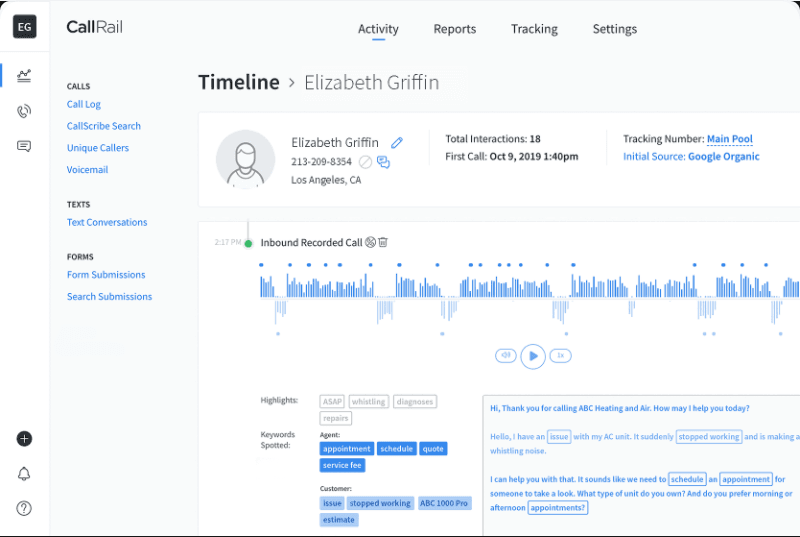
It works by giving you a unique number to use in your Google Ads. When customers call this number, the software tracks metrics such as:
- Which campaign generated the call.
- Which landing pages they visited.
- The keywords callers are searching for.
- The location of the caller.
- Time spent on the phone.
This helps you define the most impactful paid search campaigns, ads, and pages for generating phone leads.
The great thing about CallRail is that it integrates with all the software you already use. It connects to Facebook, Microsoft (Bing Ads), Google Ads, WordPress, Unbounce, and Google Analytics.
This lets you follow the prospect’s entire journey, from discovering your product to becoming a customer.
Pricing for call tracking starts at $45 per month. You can add lead center, conversion intelligence, or form tracking. However, each addition will increase the monthly cost significantly.
There’s also a 14-day free trial you can use to test out the software.
When it comes to PPC conversion tracking, CallRail is the king!
7) Unbounce: Create and Test Landing Pages
Your landing page is a crucial part of your PPC campaign. A good page boosts conversion, helping you get a better Return On Ad Spend (ROAS).
There are plenty of landing page builders out there, but our favorite is Unbounce.
Unbounce is a drag-and-drop page builder, which means you don’t need any programming knowledge to use it. You just have to choose elements you want to add to the page and customize them from within the editor.
The screenshot below shows the page builder in action. You can easily change the size, color, position, and text of all the elements.

Unbounce has over 100 templates you can use as a starting base for your pages. Or you can build templates entirely from scratch.
You can easily:
- Add video and images.
- Create brand packs with different colors, fonts, and elements.
- Build Accelerated Mobile Pages (AMP).
- Add customized lead gen forms.
- See how your landing pages are performing in the dashboard.
When creating landing pages, it’s essential to test different versions.
Unbounce makes A/B testing easy, which is the real reason why it’s on our list of top PPC tools.
All you have to do is change an element in the page builder and set it as a variant. This could be the headline, call-to-action, media, or ad copy.
You then choose how much traffic you want to send to the new version of your page. After a while, you’ll be able to see if it performs better (or worse) than the existing page. If it does, just click “Promote to Champion” to make this version of the page your main one.
Unbounce starts at $80 per month for a single domain and up to 500 conversions. Other plans go up to $300 per month.
It’s worth noting that Unbounce isn’t just for paid search. You can use it to build any kind of landing page.
8) Canva: Build Beautiful Ads
If you use social media or display ads, your visuals must be appealing. This can be daunting if you’re not a graphic designer.
The good news is that Canva makes creating great-looking designs easy. You just have to choose elements to include in your ad and then drag and drop them into place on the screen.

One of the reasons Canva is so easy to use is its ready-made templates. You can see one for Facebook Ads in the above image.
Just choose the type of media you want to create and you’ll see plenty of example creations, all with the correct dimensions. Then edit the content to your requirements.
Canva also has a vast media library. You can access thousands of stock images as well as frames, charts, shapes, drawings, and more. Adding these to your designs is as easy as choosing one and placing it in your image.
You can use the basic version of Canva for free. The Pro plan offers more design options and elements for just $10 a month.
9) Grammarly: Write Compelling Ad Copy
Writing ad copy can be challenging, especially if you’re not a professional writer.
Grammarly is a spelling and grammar checker that can help. Its functionality goes well beyond what you get on the likes of Word and Google Docs.
For starters, the spell checker and grammar checker are more comprehensive. It’s sure to find suggestions that its competitors have missed.
But the real reason it’s so powerful for PPC ads is its writing analysis.
Grammarly provides suggestions on how to:
- Make your writing clear and easy to understand.
- Make it more engaging to your audience.
- Write in an appropriate tone.
The screenshot below shows suggestions for a paragraph from the above section. Grammarly thinks the word “just” weakens my message, which means readers may think I lack confidence in what I’m saying.
This is bad, since ads need to convince people to take action. Luckily it’s an easy fix. Just click the button to remove the word.

Grammarly will never replace an expert copywriter. And the suggestions aren’t always as clear as the one above. This means you will sometimes have to use your judgment.
But the tool is an excellent way to improve your ad copy, which is why it’s on our list of top PPC tools.
There is a free version of Grammarly that checks your writing for errors. To see the more advanced suggestions you need to buy a premium subscription which costs $29.99 per month when billed monthly, or $11.66 when billed annually.
10) Optmyzr: Manage and Optimize Multiple Campaigns
Optmyzr uses algorithms to monitor your PPC campaigns and deliver insight and suggestions that may improve performance. It’s an excellent tool to help agencies manage multiple accounts.
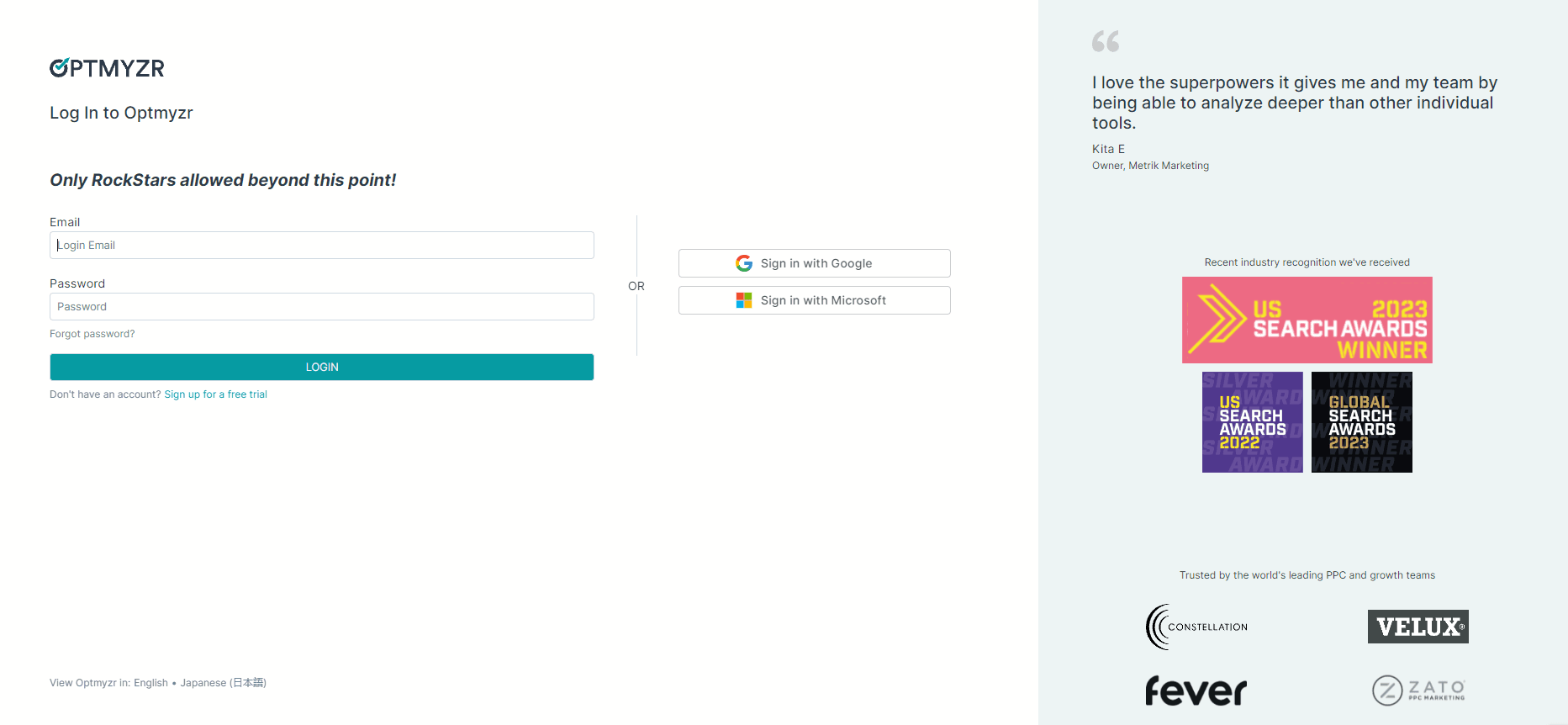
The software can help you:
- Find new keywords and avoid expensive ones.
- Optimize your bid management process so that you get maximum performance for your PPC spend.
- Test ad components, text, and placement to build more effective ads.
- Help you complete PPC audits to a high level
The best thing about this tool is how easy it is to implement suggestions.
It alerts you when it identifies something you can improve. You can review the suggestion and, if you like the idea, apply the changes in seconds.
You can use the PPC management software for all channels and formats. This includes search ads, shopping ads, Amazon advertising, Facebook Ads, Bing Ads, and more.
The tool can also handle data from many different sources, including all the major pay-per-click dashboards, Google Analytics, and even custom spreadsheets.
Optmyzr isn’t cheap, though.
The basic plan lets you manage up to 25 accounts and costs $249 per month. The Pro Plus plan is $799 per month and allows you to manage up to 50 accounts with $500k in ad spend. However, you can save money on all these accounts with an annual plan. There’s also a free trial you can use to test the software.
Despite the cost, if you’re spending a lot on ads it won’t take much of a saving to get a positive ROI.
11) Acquisio: PPC Management for Agencies
Acquisio is one of the best PPC tools to help you scale your ad campaigns. It’s especially useful for agencies that have to manage many accounts at once and would rather do so from a single dashboard.
The tool has several features that make managing accounts easy, including:
- Fast PPC campaign setup. Including templates or the ability to clone campaigns from one platform to another.
- The ability to manage keywords for multiple accounts in a single dashboard.
- Manage accounts from different platforms, including Google, Bing, Facebook, and Linkedin.
- Build reports that you can send to clients to provide full visibility into their campaigns.
- Set KPIs and targets in the dashboard. The tool will automatically show you how each account is performing compared to expectations.
The software stands out due to its optimization suite that uses machine learning to find new ways to improve campaign performance. It automatically finds high-performing keywords to bid on that deliver the highest possible ROI.
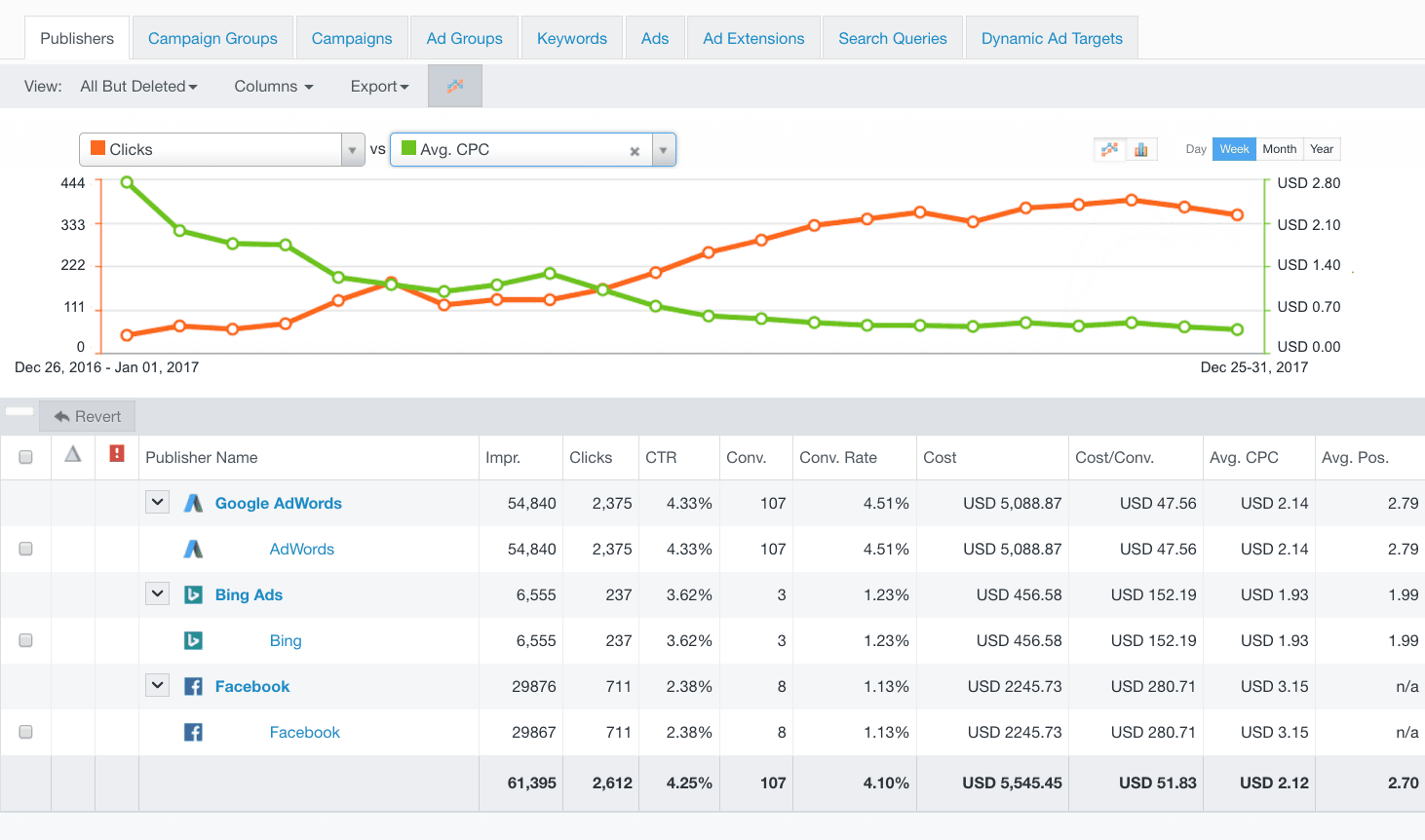
As a campaign manager, you just have to define limits and controls and let the software do the rest.
The monthly cost of using Acquisio is based on a percentage of total PPC ad spend. The exact amount you pay depends on the number of accounts you manage.
12) Google Ads Scripts
This one is totally 100% free and essential for serious PPC pros! There are literally hundreds of Google ads scripts that you can set up automatically via Google ads, that will allow you to set and forget all sorts of automations, including:
- Sending you an email if performance drops below expected
- Automatically delivering you negative keyword ideas
- Automatically telling you which are the top performing products
All of the top google ads specialists are using scripts.
PPC Tools Are Essential to Maximize ROI
PPC tools are a huge part of high-performing campaigns. They can help you optimize all elements, from planning and creation to management.
Many of the PPC tools on this list cost money. However, if you’re spending a lot on ads it doesn’t take much in terms of optimization to get savings worth the software’s price and more. Bear in mind that you’ll still need to spend a lot of time getting to grips with each piece of software, though.
A better option for some businesses is to simply outsource PPC entirely. When you do this, you’ll get experts running your campaigns who already have access to the best PPC tools—not to mention considerable expertise and experience creating great campaigns.
To find out more about how PPC.io can help, contact us here.
Here’re some other PPC tools you may want to consider:
